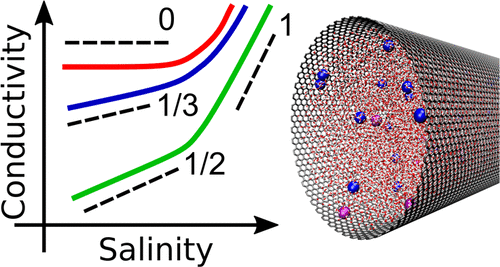当前位置:
X-MOL 学术
›
J. Phys. Chem. B
›
论文详情
Our official English website, www.x-mol.net, welcomes your feedback! (Note: you will need to create a separate account there.)
Crossover of the Power-Law Exponent for Carbon Nanotube Conductivity as a Function of Salinity
The Journal of Physical Chemistry B ( IF 3.3 ) Pub Date : 2018-02-28 00:00:00 , DOI: 10.1021/acs.jpcb.8b01975 Yuki Uematsu 1, 2 , Roland R. Netz 2 , Lydéric Bocquet 3 , Douwe Jan Bonthuis 2
The Journal of Physical Chemistry B ( IF 3.3 ) Pub Date : 2018-02-28 00:00:00 , DOI: 10.1021/acs.jpcb.8b01975 Yuki Uematsu 1, 2 , Roland R. Netz 2 , Lydéric Bocquet 3 , Douwe Jan Bonthuis 2
Affiliation

|
On the basis of the Poisson–Boltzmann equation in cylindrical coordinates, we calculate the conductivity of a single charged nanotube filled with electrolyte. The conductivity as a function of the salt concentration follows a power-law, the exponent of which has been controversially discussed in the literature. We use the co-ion-exclusion approximation and obtain the crossover between different asymptotic power-law behaviors analytically. Numerically solving the full Poisson–Boltzmann equation, we also calculate the complete diagram of exponents as a function of the salt concentration and the pH for tubes with different radii and pKa values. We apply our theory to recent experimental results on carbon nanotubes using the pKa as a fit parameter. In good agreement with the experimental data, the theory shows power-law behavior with the exponents 1/3 at high pH and 1/2 at low pH, with a crossover depending on salt concentration, tube radius and pKa.
中文翻译:

碳纳米管电导率随盐度变化的幂律指数的交叉
根据圆柱坐标中的Poisson–Boltzmann方程,我们计算了填充有电解质的单个带电纳米管的电导率。电导率作为盐浓度的函数遵循幂律,在文献中有争议地讨论了幂指数。我们使用co-ion-exclusion逼近并通过分析获得不同渐近幂律行为之间的交叉。通过数值求解完整的Poisson–Boltzmann方程,我们还计算了不同半径和p K a值的管的指数随盐浓度和pH值的变化的完整图。我们将理论应用于使用p K a的碳纳米管的最新实验结果作为拟合参数。与实验数据非常吻合,该理论显示了幂律行为,指数在高pH下为1/3,在低pH下为1/2,并且交叉取决于盐浓度,管半径和p K a。
更新日期:2018-02-28
中文翻译:

碳纳米管电导率随盐度变化的幂律指数的交叉
根据圆柱坐标中的Poisson–Boltzmann方程,我们计算了填充有电解质的单个带电纳米管的电导率。电导率作为盐浓度的函数遵循幂律,在文献中有争议地讨论了幂指数。我们使用co-ion-exclusion逼近并通过分析获得不同渐近幂律行为之间的交叉。通过数值求解完整的Poisson–Boltzmann方程,我们还计算了不同半径和p K a值的管的指数随盐浓度和pH值的变化的完整图。我们将理论应用于使用p K a的碳纳米管的最新实验结果作为拟合参数。与实验数据非常吻合,该理论显示了幂律行为,指数在高pH下为1/3,在低pH下为1/2,并且交叉取决于盐浓度,管半径和p K a。



























 京公网安备 11010802027423号
京公网安备 11010802027423号